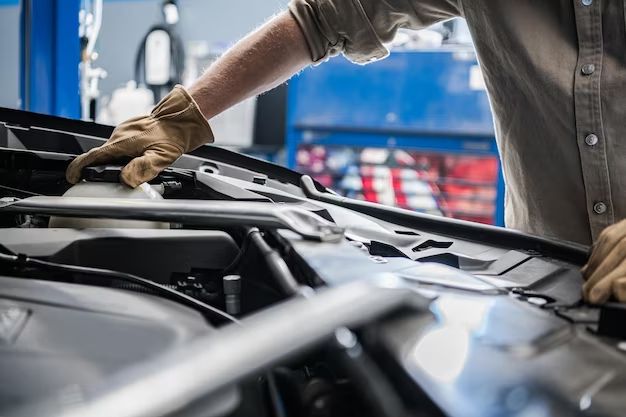Checking the antifreeze level and condition is an important part of routine vehicle maintenance. Antifreeze, also known as engine coolant, circulates through the engine and keeps it from overheating. It also provides freeze and corrosion protection.
Page Contents
What you’ll need
To check the antifreeze level, you’ll need a few supplies:
- Antifreeze tester
- Funnel (if adding antifreeze)
- Antifreeze (if adding antifreeze)
Locating the antifreeze reservoir
Most vehicles have a plastic antifreeze reservoir tank mounted in the engine compartment. It’s usually transparent so you can see the fluid level. If you can’t easily find it, consult your owner’s manual for the location.
Checking the level
Here are the steps to check the antifreeze level using a tester:
- Make sure the engine is cold before checking the level. If the engine is hot, wait for it to cool completely.
- Locate the antifreeze reservoir tank under the hood and wipe any dirt or debris from the cap and opening.
- Unscrew the cap from the reservoir and set it aside.
- Visually inspect the fluid level. It should be at the “Full” or “Max” line on the side of the tank. If it’s low, you’ll need to add more antifreeze.
- Insert the tester into the reservoir opening. It will have one or more sensors that change color depending on the freeze point and chemical makeup of the antifreeze.
- Compare the color change to the chart on the tester to determine the antifreeze concentration. It should fall within the acceptable range recommended by your manufacturer, typically a 50/50 or 40/60 mix of antifreeze and water.
- If the concentration is low, add the appropriate amount of antifreeze to bring it up to the proper level. Use premixed antifreeze or mix concentrated antifreeze with distilled water to the desired ratio.
- Clean the tester with water and replace the reservoir cap once finished.
Using an electronic antifreeze tester
Electronic antifreeze testers provide precise measurements through built-in sensors. To use one:
- Turn on the tester and insert the sensor probe into the reservoir opening.
- Allow the sensor to sit in the fluid for the required time, usually around 1-2 minutes.
- The tester will display the freeze point, boiling point, and antifreeze-to-water mix ratio on the digital screen.
- Compare the results to your manufacturer’s specifications. Add antifreeze as needed to achieve the right concentration.
- Remove the sensor probe from the reservoir and rinse off any residual fluid.
Interpreting the results
Here’s how to interpret the results from different types of testers:
Color-based tester
- Green or yellow: Antifreeze concentration is adequate
- Red, amber, or brown: Antifreeze level is low and needs to be topped up
- Blue or purple: Antifreeze concentration is too high and needs to be diluted
Electronic tester
- Freeze point between -30°F and -34°F (-34°C and -37°C): Antifreeze concentration is optimal
- Higher freeze point: Antifreeze concentration is too low
- Lower freeze point: Antifreeze concentration is too high
Refractometer
- Reading between -32°F and -36°F: Optimal freeze and corrosion protection
- Higher reading: Antifreeze concentration needs to be increased
- Lower reading: Antifreeze concentration needs to be decreased
Adding antifreeze
If the antifreeze level is low, add a 50/50 premixed antifreeze or mix concentrated antifreeze with distilled water. Here’s how:
- Park your vehicle on level ground and apply the parking brake.
- Locate the antifreeze reservoir under the hood.
- Unscrew the reservoir cap and set it aside.
- Use a funnel to slowly pour the premixed antifreeze into the reservoir. Leave space at the top for expansion.
- Alternatively, mix the concentrated antifreeze with distilled water in a container before adding it to the reservoir.
- Check the antifreeze level again with the tester to confirm the concentration is correct.
- Replace the reservoir cap.
- Start the engine and let it idle for a few minutes. Turn the heater on to circulate the antifreeze.
- Turn off the engine and let it cool. Check for leaks around the reservoir cap.
- Check the antifreeze level one more time once the engine has cooled. Top up if necessary.
Flushing the antifreeze system
If the antifreeze color is dirty, rusty, or contaminated, you may need to flush the entire cooling system:
- Drain the old antifreeze into a clean container using the petcock valve.
- Fill the system with distilled water and run the engine to temperature.
- Drain the distilled water and repeat the flush process as needed.
- Refill with fresh, premixed antifreeze once flushing is complete.
- Dispose of old antifreeze properly. Most municipalities have special waste drop offs.
Checking antifreeze condition
In addition to checking antifreeze levels, also inspect its condition. Signs of contaminated or degraded antifreeze include:
- Color change – Antifreeze should have bright, translucent green or yellow color. If it’s brown, rusty, or milky, it needs to be changed.
- Greasy residue – Oil contamination will leave an oily film on the dipstick or inside the reservoir.
- White scaling – Hard water deposits cause calcium scaling on surfaces the antifreeze contacts.
- Odors – The smell of burnt food indicates antifreeze breakdown.
- Foaming – Excessive foaming inside the radiator or reservoir is a sign of chemical deterioration.
When to change the antifreeze
You should flush and change the engine antifreeze according to your manufacturer’s maintenance schedule, typically every 2-3 years or 30,000-60,000 miles. It may need to be changed more frequently under certain driving conditions like frequent short trips, extreme temperatures, or towing heavy loads.
Conclusion
Checking antifreeze levels and condition regularly with a tester is quick and easy maintenance. Make sure to use the proper 50/50 antifreeze mix for your climate. Top up or flush the system as needed to prevent overheating issues and cooling system corrosion down the road.
